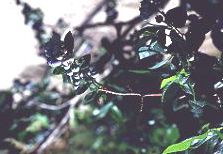
Terminal borer, Recurvaria spp. (Gelechiidae)
Biology: Commonly found infesting growing terminals of blueberry canes and similar plants in North Carolina (Milholland & Meyer 1984). Moth wingspread 6 mm, grayish white with numerous black and brown markings. Larvae smooth, ca. 8 mm long, dark reddish on most of body (distinctive), head dark brown. Larvae are associated with blueberry for only short time. Eggs are laid early in the season in tips of expanding terminals, and larvae bore into these tips. Larvae develop here during April and May. Pupae during late May or June, probably in soil. Hollow out the tender terminals for distance of about 2-4 inches . Terminal leaves wilt, become partially consumed. Dries, turns purplish brown. "Unless plants are heavily infested with terminal borers, the injury apparently has little effect on productivity . Insecticides applied in the spring for the major blueberry pests usually cause a sharp decrease in Recurvaria populations; no additional control of this species is necessary." (Milholland & Meyer 1984).
Blueberry tip borer, Hendecaneura shawiana (Kearfott)
Biology: Not recognized as blueberry pest until 1950's, in New York. Sometimes seen in western North Carolina, not Coastal Plain (Milholland & Meyer 1984). Overwinter as larvae in the hollow blueberry canes where they feed during the summer. Slender caterpillars, light pink at first,fades as mature. About 12 mm when mature. Larvae pupate in May, adults emerge in June. Mostly brown, but each front wing has orange marks near tip and a silver spot along hind margin. Wingspan of 9.5-14.5 mm. Oviposit on lower surface of leaves, bore into the canes 5-15 cm from tip. Larvae feed throughout summer and early fall, digging tunnel toward base of cane. During July and August, distal portion of stem wilts, turns brown. Kills 20-25 cm (8-10 in) . In spring conspicuous dieback of terminals. It is difficult to assess impact . When tips are injured, secondary growth compensates, at least in part (Milholland & Meyer 1984). Heavy infestation will not kill plants, but there may be some yield reduction.
Control: (Milholland & Meyer 1984): Cut out dead canes at pruning time, will keep damage light. Don't need to remove prunings because tip will dry out. Several wasps give some biological control. Fruitworm sprays often control this pest (Marucci 1966, Penn.). Marucci (1966) reported decreasing order of susceptibility: Cabot, Concord, Rancocas, Pioneer.
Stem borer, Oberea myops Hald. (Cerambycidae)
Biology: The adult is a longhorned beetle about 15 mm long, brown with two dark spots on the pronotum. Females oviposit in current season's growth near tip in June or July. Two parallel girdles about 1/2 inch apart; egg is laid between rows (Marucci 1966). Larva feeds in cane, adult emerges after about three years. The first year, larva tunnels a few inches, second year it may reach crown, third year may enter another stem from crown (Marucci 1966). Shoot girdling associated with oviposition, tips wilt. As larva tunnels down, whole cane affected, leaves turn reddish-brown, drop. Whole cane dies. Cane may have pin holes down length with frass extruding, and this frass may accumulate in a pile at the base of the plant. Woolwine et al. (1996) reported differences in infestation among rabbiteye blueberry cultivars. Some additional information as well as some images may be found at an Oberea page posted by NCSU.
Control: Remove wilted tips as soon as they appear. Easy to see, so shouldn't miss many (Marucci 1966).
Prionus spp. (Cerambycidae)
See additional comments on Prionus under apple.
Biology: Resemble Oberea larvae , but have tiny thoracic legs, lack spines behind head and grow much larger, 65 mm (2.5 in) (Milholland & Meyer 1984). Lay eggs in crevices in bark or in partially exposed roots. Small alrve feed just under epidermis; larger learvae tunnel in roots. Larvae for 3-5 years.
Control: (Milholland & Meyer 1984): "As in the case of crown girdlers, a soil insecticide can be applied in a band around the base of a blueberry plant to kill Prionus larvae. This strategy is usually most effective against young individuals which have not penetrated too deeply into the crown or roots. Older larvae may be exceedingly difficult to kill."
Additional Reading: